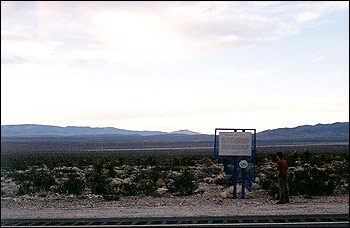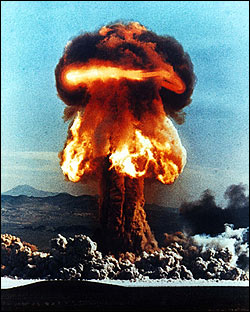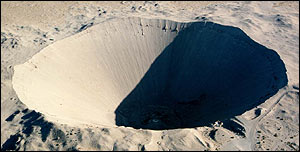Nellis Range, Nevada Test Site and Nellis Air Force Base - Sites of Interest |
Area 2 Once known as 'Lake Mead Base', this complex to the East of Nellis AFB is a storehouse for conventional and non-conventional (nuclear) weapons. It is surrounded by a high electrified fence and it comprised of a series of earthen bunkers in addition to various other buildings and dorms. It is also the home the Nellis Federal Prison Camp.  NTS Sign on US-95 outside of Mercury, NV
(For full text, see footnote.)
Frenchman Flat  If you've ever seen a film of a nuclear weapons test with soldiers hunkered down in trenches, or homes, cars, or trees being blasted away, this is where it happened. Dozens of so-called 'atmospheric' tests were conducted here to demonstrate the viability of certain methods or structures in the event of nuclear war. Only relatively low-yield atomic weapons were tested above ground on Frenchman Flat and the nearby Yucca Flat. High-yield weapons like the thermonuclear bombs were still tested in the South Pacific because they were too large and hazardous for continental testing.
If you've ever seen a film of a nuclear weapons test with soldiers hunkered down in trenches, or homes, cars, or trees being blasted away, this is where it happened. Dozens of so-called 'atmospheric' tests were conducted here to demonstrate the viability of certain methods or structures in the event of nuclear war. Only relatively low-yield atomic weapons were tested above ground on Frenchman Flat and the nearby Yucca Flat. High-yield weapons like the thermonuclear bombs were still tested in the South Pacific because they were too large and hazardous for continental testing.To the right is an example of one of the atmospheric 'shots' as they were called. This shot was a test on Frenchman Flat of an experimental weapon fired from an artillery shell, only 28 centimeters in diameter. It was the only test of an artillery shell device. U.S. Department of Energy Photograph
Sedan Crater In one of largest underground tests in US history, a 1-Megaton yield weapon was placed 630 feet down on Yucca Flat and detonated. It launched massive amounts of debris into the air and formed the largest crater at the NTS. Sedan was part of the 'Plowshare' program, an effort to explore possible peaceful uses of nuclear devices. (Among these would be excavation, drilling, etc.) 
U.S. Department of Energy Photograph Mercury, the second largest town in Lincoln county, is the DOE's base of operations for the Nevada Test Site. There is not much to see here except some operations buildings and drab government housing. Yucca Mountain Yucca Mountain is the future site of the nation's nuclear waste depository. Feasibility tests have been ongoing to determine if the mountain is a stable, suitable site to hold these wastes from nuclear plants, and industrial and medical byproducts. It is located near Yucca flat inside the Test Site. Located Southeast of the town of Tonopah and at the northwestern edge of the Nellis Range, the Tonopah Test Range is a testing ground for new aircraft and concepts. Much like the Groom Lake Facility, it provided a home to the F-117A Stealth Fighter in the later years of its development. The TTR includes an airbase as well as radar testing grounds, and security is less intense than that at Groom Lake. You can see the airbase from vantage points off of US-6, and as long as you stay outside the fence you should be okay. *NTS Sign text: Testing of devices for defense and for peaceful uses of nuclear explosvies is conducted here. The nation's principal nuclear explosives testing laboratory is located within this 1,350 square miles, geologically complex, area in the isolated valleys of Jackass, Yucca, and Frenchman flats. Selected as an on-continent test site in 1950, the first test took place on frechman flat in January, 1951. Archelogical studies of the NTS area have revealed continuous occupation by prehistoric man from about 9,500 years ago. Several prehistoric cultures are represented. The last aboriginal group to occupy the site was the Southern Paiute who foraged plat foods in season and occupated the area until the coming of the pioneers. |
May 2001 - For Technical Communication, English 271
Last updated: 3 May 2001
Last updated: 3 May 2001